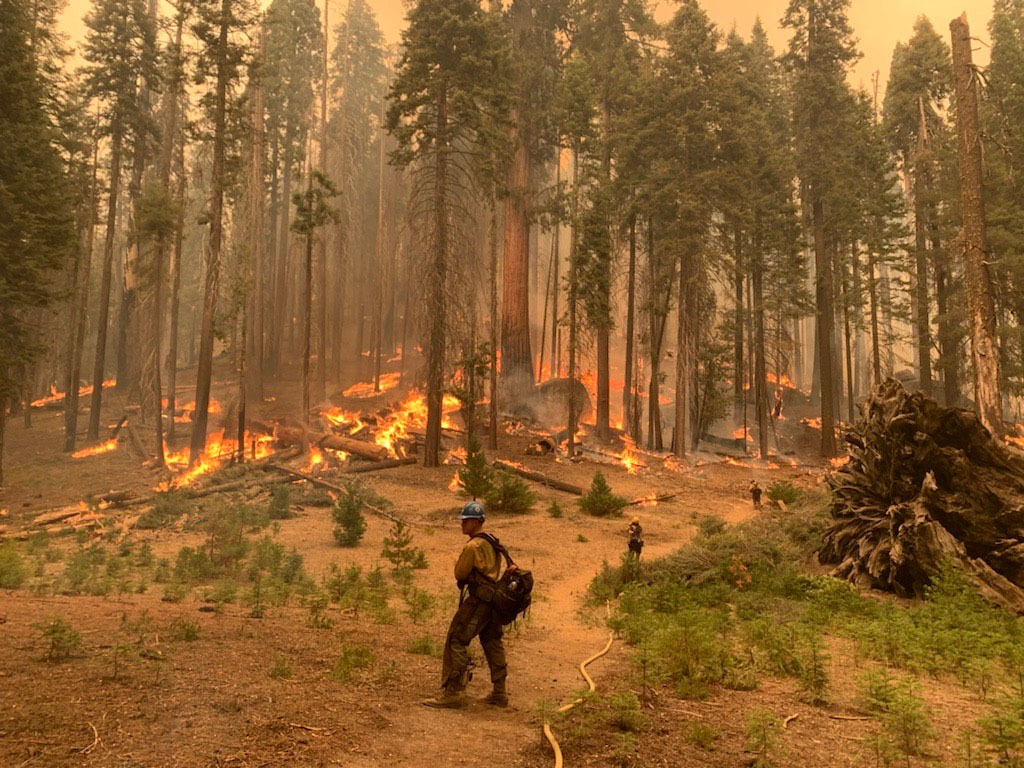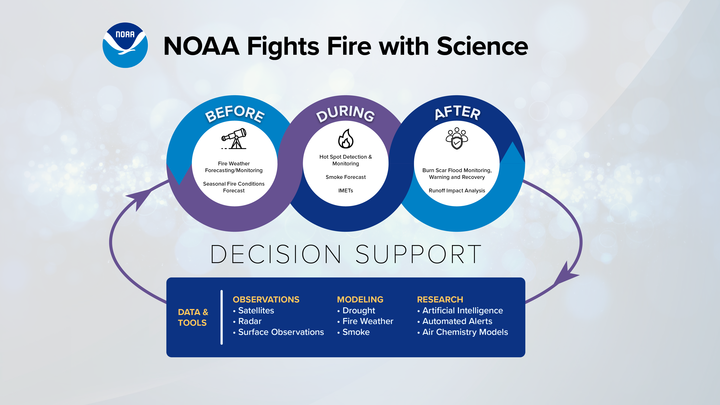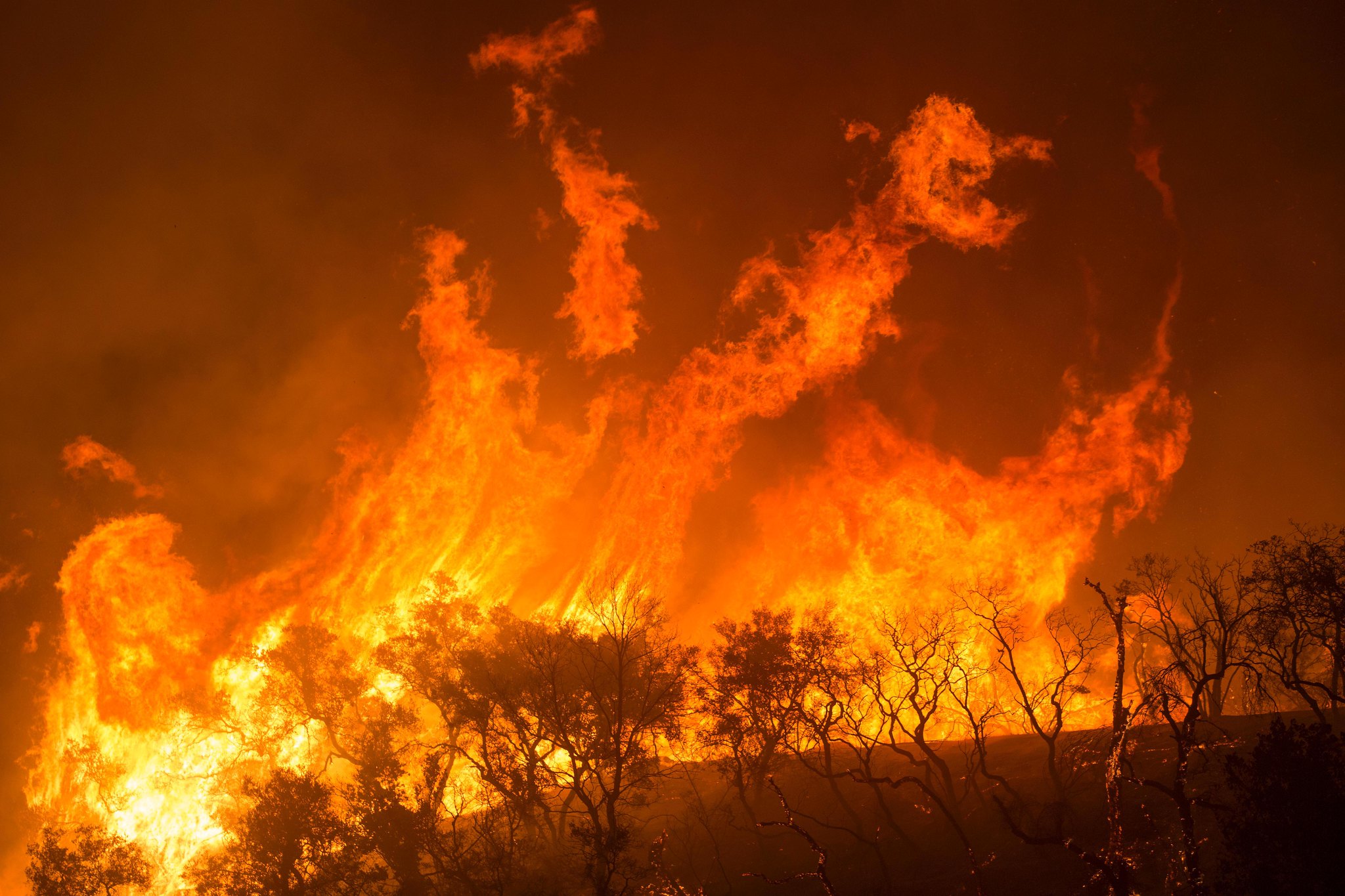NOAA Fire Weather Testbed
To completely address challenges involving the total fire environment, an operations-to-research-to-operations testbed entirely focused on wildland fire from both physical and social science aspects is essential.

What is the NOAA Fire Weather Testbed?
There is a growing need across Federal, State, Local, and Tribal governments and agencies for new and improved models, observations, technologies, and tools to support decisions involving wildland fire. To completely address challenges involving the total fire environment, an operations-to-research-to-operations testbed entirely focused on wildland fire from both physical and social science aspects is essential.
What are the objectives for the NOAA Fire Weather Testbed?
NOAA has five main objectives for the Fire Weather Testbed.- Transition advanced technologies and new applications to operational platforms as quickly as possible.
- Bring the fire weather community together to leverage broad knowledge and expertise to understand information needs and to co-create technology, resulting in quicker technological advances.
- Leverage the expertise within NOAA to accelerate and target the delivery of technologies to operational platforms and applications.
- Ensure continuous operations-to-research connections of the fire environment developed through ongoing, iterative user needs-driven assessments
- Reach beyond NOAA and the Federal government to build partnerships facilitating collaborations across Tribes, state agencies, municipalities, academia, non-governmental organizations, and communities engaged in wildland fire management.

The NOAA Fire Weather Testbed aims to accelerate the development and delivery of products, technologies, and communication strategies to users. This includes evaluating capabilities that:
- Support National Weather Service products such as Red Flag Warnings to provide situational awareness and prevent ignitions
- Provide services to safely mitigate dangerous wildland fires
- Aid implementation of prescribed fire and wildfire management to achieve resource benefits, minimize negative impacts on life and property, and reduce future fire hazard
- Help communities prepare for hazards before, during, and after wildland fire.
By supporting all aspects of the fire cycle-- before ignitions, during active fire, and throughout the postfire recovery process--the Fire Weather Testbed will facilitate operational-needs-driven research advancements back to operations. These technological and communication improvements will enhance community resilience and build a fire-ready nation prepared to live with fire.
The NOAA Fire Weather Testbed is a collaborative effort between three NOAA line offices: Global Systems Laboratory (GSL), the National Weather Service (NWS), and the National Environmental Satellite, Data, and Information Service (NESDIS).

Firefighters stand along a fireline monitoring a burnout operation intended to re-introduce low intensity fire into a fire-adapted mixed conifer forest in the Sequoia National Park (September 2021).
BEFORE FIRE
Preparation and readiness are keys to success in natural hazard management. Before fires ignite, we need better forecasts and decision-support tools to identify potentially high-impact fire weather environments. This will help decision-makers mobilize and pre-deploy resources to mitigate the potential for catastrophic wildfires, especially those potentially reaching the wildland-urban interface. Before fire, we need:
- Improved forecasts for the potential for dry lighting outbreaks
- Better long-range to sub-seasonal forecasts to assist in the implementation of prescribed fire or “good fire” on our landscapes, help mitigate the potential for future devastating fires, and to restore ecosystem function
- Probabilistic forecasts of the long-range weather and smoke transport to ensure safe implementation and communication during prescribed fires.

DURING FIRE
Once a fire ignites, observing current and forecasting future environmental conditions driving fire behavior is necessary to safely and effectively achieve fire management objectives. During fire, we need:
- Better high-resolution forecasts in rugged terrain to help Incident Meteorologists provide critically important weather information to fire managers
- Coupled fire-atmosphere models to better predict rapid fire spread
- Advanced predictive tools for complex and dynamic problems, like pyrocumulus development
- Skillful forecasts of local and long-range smoke transport to provide valuable information for protecting public health and safety.
AFTER FIRE
Once the flames are extinguished, the challenges of fire do not end. Postfire hazards range from falling trees to soil erosion. Transport of newly formed and mobilized environmental pollutants in the air and water can persist for years after fire. Following fire, we need:
- Skillful forecasts of short-duration, high-intensity rainfall that triggers post-fire hazards such as flash flooding and debris flows that contribute to erosion, sediment, and pollutant transport, impacting infrastructure, public safety, and ecosystem health
- Improved understanding and monitoring of how landscapes recover in the years following fire to inform adaptive management of natural and urban settings to enhance resiliency.
How will the NOAA Fire Weather Testbed address these challenges?

Wildland fire knows few boundaries, therefore the list of operational and research partners spans local, state, Federal, and Tribal governments, non-governmental organizations, academia, and beyond. The Fire Weather Testbed provides the infrastructure (virtual and on-site) and quasi-operational framework for researchers, operational experts, and partners to advance science to develop solutions that improve operations, services, and decision-making capabilities across jurisdictional and scientific boundaries. The Fire Weather Testbed will involve physical science but heavily rely on social and behavioral science. Social and behavioral science techniques will:
- Allow the assessment of user needs
- Evaluate decision-making methods
- Ensure improvements to existing tools and new products are correctly interpreted, used, and communicated to end-users and partners.
These three goals closely align with the NOAA Weather Program Office’s Social, Behavioral, and Economic Sciences program and efforts by other Federal agencies such as the U.S. Geological Survey, U.S. Forest Service, and the National Weather Service.




































